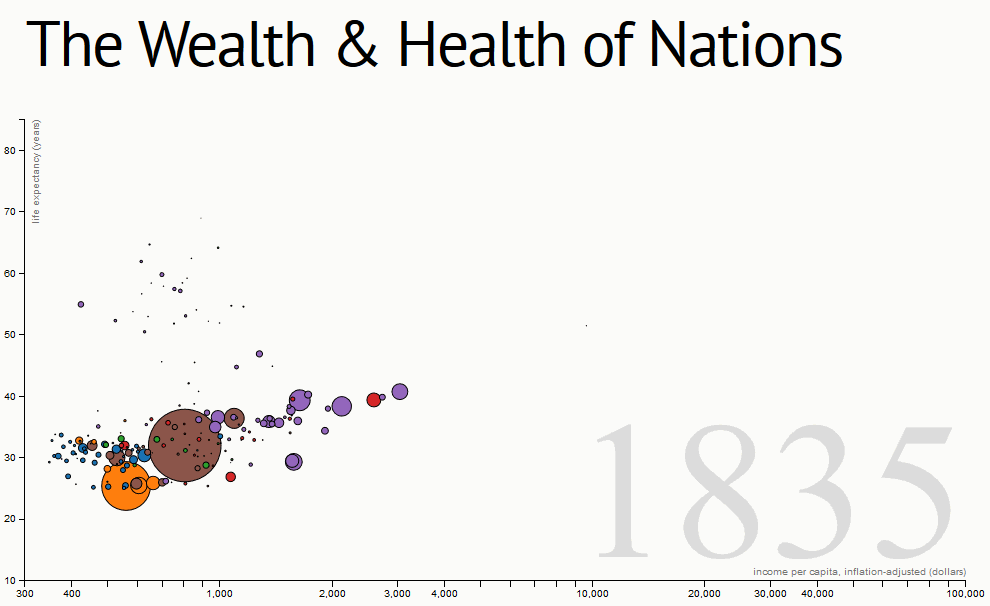该代码的目的是缺少一年(或更多)数据的情况,在您发布的示例数据中似乎并非如此。首先,它发现使用的最接近的数据点使用 bisect.left 然后计算上一个数据点和当前数据点之间的推断。
特别注意 year - a[0] 在您的情况下,所有年份都存在(这计算了要求的年度和发现年之间的差异)。因此,整个期限为0,返回值对应于 a[1].
如果要求的一年不存在, t 表示描述上一年变化的因素 b 和当年 a. 。这种变化因素用于推断过去 a 获得所需年的价值。
题
我正在努力进行视觉化 http://bost.ocks.org/mike/nations/:

我对插值功能有一个查询。最初称为mousemove,称为displayyear,在该示例中调用了Interaplate数据。
function mousemove() {
displayYear(yearScale.invert(d3.mouse(this)[0]));
}
}
// Tweens the entire chart by first tweening the year, and then the data.
// For the interpolated data, the dots and label are redrawn.
function tweenYear() {
var year = d3.interpolateNumber(thisyear, 2009);
return function(t) { displayYear(year(t)); };
}
// Updates the display to show the specified year.
function displayYear(year) {
//alert(year);
thisyear=year;
dot.data(interpolateData(year), key).call(position).sort(order);
label.text(Math.round(year));
}
// Interpolates the dataset for the given (fractional) year.
function interpolateData(year) {
return nations.map(function(d) {
return {
name: d.name,
region: d.region,
checkins: interpolateValues(d.checkins, year),
teamsize: interpolateValues(d.teamsize, year),
Checkintimes: interpolateValues(d.Checkintimes, year)
};
// Finds (and possibly interpolates) the value for the specified year.
function interpolateValues(values, year) {
var i = bisect.left(values, year, 0, values.length - 1),
a = values[i];
if (i > 0) {
var b = values[i - 1],
t = (year - a[0]) / (b[0] - a[0]);
return a[1] * (1 - t) + b[1] * t;
}
return a[1];
}
这个功能有什么作用?我尝试调试,发现它比较了2年并进行计算,然后返回值。谁能阐述这个?
JSON文件包含
[
{
"name":"India",
"region":"South Asia",
"income":[[2000,225],[2001,225],[2002,226],[2003,227],[2004,229],[2005,230],[2006,231],[2007,244],[2008,254],[2009,253]],
"population":[[2000,41542812],[2001,41623424],[2002,41866106],[2003,42186202],[2004,41521432],[2005,41827315],[2006,42127071],[2007,42420476],[2008,42707546],[2009,42707546]],
"lifeExpectancy":[[2000,43.56],[2001,43.86],[2002,44.22],[2003,64.61],[2004,56.05],[2005,56.52],[2006,66.02],[2007,68.54],[2008,67.06],[2009,73.58]]
}
]
解决方案
该代码的目的是缺少一年(或更多)数据的情况,在您发布的示例数据中似乎并非如此。首先,它发现使用的最接近的数据点使用 bisect.left 然后计算上一个数据点和当前数据点之间的推断。
特别注意 year - a[0] 在您的情况下,所有年份都存在(这计算了要求的年度和发现年之间的差异)。因此,整个期限为0,返回值对应于 a[1].
如果要求的一年不存在, t 表示描述上一年变化的因素 b 和当年 a. 。这种变化因素用于推断过去 a 获得所需年的价值。